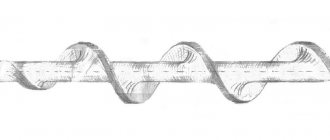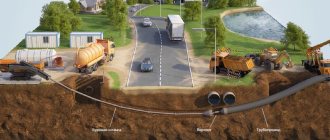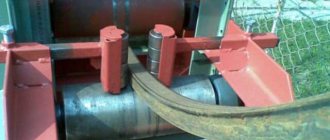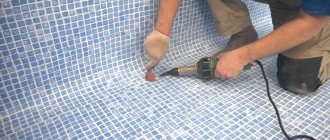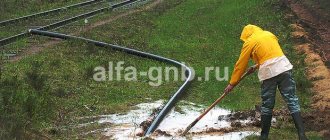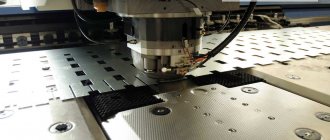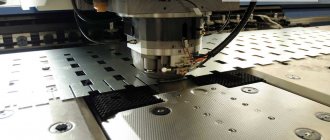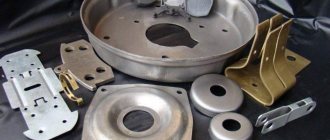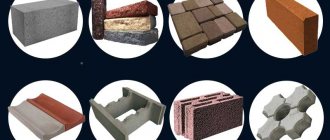When laying pipelines, pipes are usually laid in trenches to the designed depth. But in urban or cramped conditions, situations arise when a pipe line crosses water bodies, roads and railways, architectural structures, a unique landscape, and for technical reasons, trenchless pipe laying is required.
Several technologies have been developed for carrying out work in this area, using special equipment and qualified specialists. Each of the methods is designed for specific communications and overall dimensions of the line being laid and, despite complex and expensive equipment, brings an economic effect.
Rice. 1 Trenchless pipeline laying
Pipe insulation methods
Insulation for pipes
Thermal insulation of water pipes is necessary. This especially applies to the above-ground part of the pipe, located outdoors and in unheated rooms.
As insulation, you should choose a non-flammable and moisture-resistant material that will not swell when in contact with condensate. It must be resistant to environmental influences and temperature changes.
Thermal fiber and basalt wool are used from sheet materials. They retain heat well, but require an external waterproofing layer.
Convenient and inexpensive material - polystyrene foam. Cases made from it are sold in hardware stores. All that is required is to enclose the pipe in a heat-protective casing and seal it with several layers of tape. Heat insulators made specifically for pipes are convenient when working with corners and turns.
Expanded polystyrene is used for both external and internal work, and it is quite durable, which facilitates its reuse if it is necessary to dismantle the system.
If you place a water pipe inside another pipe, an air cushion is formed between their walls, which retains heat. But this is an additional measure; insulation will still be required.
If you follow all the rules for underground communications, you can independently install high-quality water supply that will last for many years.
How to make a puncture yourself
Do-it-yourself soil piercing
The practical implementation of the method of trenchless pipe laying with your own hands is possible only over a relatively short area (no more than ten meters), and also if you are in good physical shape, which would allow you to perform heavy work operations. As for the equipment necessary for such work, you will definitely need the following simple tool:
- a simple welding machine;
- ordinary "grinder";
- small sledgehammer;
- reinforcement no thicker than 20 millimeters;
- steel pipe of your chosen diameter (several pieces);
- pump equipped with a plastic pipe;
- plastic barrel with a neck (capacity up to 200 liters);
- funnel with a hose up to 2 meters long.
The trenching process usually includes the following steps:
- Preparing a ditch on both sides of the route (with a margin of 12-13 cm). When digging it, the axis of the pipe that you plan to lay is outlined.
- After this, a pipe blank is taken and the end that is intended for driving into the ground is sharpened. In this case, it is best to cut teeth on it using a grinder.
- As you carry out all these operations (after each successive pushing of the pipe), you should wash out the soil from its hollow part.
- After each successive “rinsing” of the pipe, you should continue plugging it in with a sledgehammer.
Equipment
To carry out HDD, machines and tools are used that can pierce the top layers of soil and go deeper. Based on the volume of work and type of soil, these can be special hammer drills, motor drills or drilling machines. The first 2 options are usually used for personal use, while drilling machines are used on large objects, strong and hard soils.
Cars
A drilling machine or HDD rig is a type of industrial equipment that runs on diesel. The main functional elements of the machine are the hydraulic station, carriage, and control panel. The latter allows the operator to control the operation and movement of the machine and looks like a special remote control. Directly creating a trench is possible thanks to the drill. During rotation, the drill heats up, which can lead to rapid failure. This can be avoided by regularly cooling the metal part with water. For this purpose, a water supply hose is used - another element of the drilling machine.
Drilling equipment is classified based on the limiting pulling force (measured in tons), maximum drilling length and borehole diameter. Based on these parameters, the drill power is calculated. A more compact analogue of a drilling rig is a motor drill. Its main purpose is to perform small earthworks. However, the piercing part of the drilling process in some cases is quite easily and quickly performed with a motor drill. Since a motor drill operates as an auger, it is often called a press-screw machine. This setup includes a drill, a rod and a motor.
Location systems
Such a system is necessary for precise control of the trajectory of the drill head and its exit to the location of the second puncture. It is a probe attached to the drill head. Workers monitor the location of the probe using locators.
Auxiliary Tools
This type of tool becomes necessary at the stage of soil puncture. Rods, threaded screw tools, expanders, and pumps are used. The choice of a specific tool is determined by the type of soil and the stages of work. Auxiliary tools also include clamps and adapters, the main task of which is to help in obtaining a pipeline of the required length. To obtain a channel of the required diameter, expanders are used. Water is supplied to the installation using a pump system. Generators ensure uninterrupted operation of the equipment, and the lighting system allows drilling even in the dark.
Puncture under the road
Puncture under the road is the most profitable, fast and expedient solution to your problem of laying communications, mainly pipes, without digging trenches! After all, to carry out work using this method, only 2 small pits are enough, and with the HDD method there is no need to dig holes at all! Thanks to our services, you have the opportunity to lay the communications you need, avoiding various obstacles along their route, the most common of which are roadways. Our work is carried out using professional compact equipment - soil puncture units with a controlled trajectory. This allows us to make punctures with high precision from small pits and from the basements of houses.
Our advantages:
- We lay sewer pipes with the required slope.
- We install pipes into an existing well.
- It is possible to bring equipment into the work area manually.
- The installation operates from a pit with dimensions of 1.8 x 2.3 meters.
Characteristics:
- The length of one puncture under the road is from 5 to 70 meters.
- Pipe diameter – from 32 to 315 mm.
- Types of pipelines - water, gravity sewer, pressure sewer, gas cases, cases for various cables (electric, telephone, fiber optic).
- Speed of work: from 20 to 100 meters per day.
Self-puncture is performed using the following technology
- Along the expected puncture line, the pointed end is driven into the working pit with a sledgehammer into steel reinforcement. It serves as a guide for the pipe and warns of difficult obstacles in its path. The length of the reinforcement rod should not exceed two meters, otherwise the material may be deformed under the blows of a sledgehammer. As it enters the ground, the next section is welded and hammered in again. Work continues until the end appears on the other side of the road;
- On both sides of the road under which communications need to be laid, two pits (pits) are dug symmetrically. The depth of the pits should be slightly greater than the depth of the pipe. The pipe will be driven horizontally through the first pit until it appears on the other side. The dimensions of the working and receiving pit are selected taking into account the above and must provide for the possibility of a person being freely in it;
- Using the same technology, a puncture is made with a pipe placed on the fittings. To prevent the ends from breaking, a nozzle with jagged, sharpened edges is installed in front, and a glass-shaped nozzle is installed at the back. Under the blows of a sledgehammer on the bottom of the glass, the pipe begins to go into the ground. As it moves, the earth becomes compacted in the pipe and movement stops. A jet from the water pump removes it quite easily. Further actions are consistent until the nozzle appears in another pit.
There are various variations of this method:
- Using a bailer made from a large hydraulic cylinder;
- Using a mini horizontal drilling unit or various auxiliary means for driving in reinforcement, for example, a drill;
- Puncture at the pump base.
Having scoured the Internet, we found a thousand and one more ways of “author’s” laying communications underground. We have never doubted the unique abilities of folk craftsmen, but we still recommend that you use one of the methods we propose, since these methods are the most reliable and have a technical basis. It's better not to take risks.
Since the issue of self-piercing is mostly of interest to private property owners who want to either modernize their site or connect communications to it, it is worth remembering that even if the land is on your property, you cannot just take it and drill under it. This is especially true for work that is planned to go beyond private territory. We also note that punctures over 10 meters in length are performed using special equipment and using the HDD method.
How to make a puncture yourself
Self-puncture of the soil
The practical implementation of the method of trenchless pipe laying with your own hands is possible only over a relatively short area (no more than ten meters), as well as if you are in good physical shape, which would allow you to perform heavy work operations. As for the equipment necessary for such work, you will definitely need the following simple tool:
- a simple welding machine;
- ordinary "grinder";
- small sledgehammer;
- reinforcement no thicker than 20 millimeters;
- steel pipe of your chosen diameter (several pieces);
- pump equipped with a plastic pipe;
- plastic barrel with a neck (capacity up to 200 liters);
- funnel with a hose up to 2 meters long.
The trenching process usually includes the following steps:
- Preparing a ditch on both sides of the route (with a margin of 12-13 cm). When digging it, the axis of the pipe that you plan to lay is outlined.
- After this, a pipe blank is taken and the end that is intended for driving into the ground is sharpened. In this case, it is best to cut teeth on it using a grinder.
- As you carry out all these operations (after each successive pushing of the pipe), you should wash out the soil from its hollow part.
- After each successive “rinsing” of the pipe, you should continue plugging it in with a sledgehammer.
Self-puncture is performed using the following technology
- Along the expected puncture line, the pointed end is driven into the working pit with a sledgehammer into steel reinforcement. It serves as a guide for the pipe and warns of difficult obstacles in its path. The length of the reinforcement rod should not exceed two meters, otherwise the material may be deformed under the blows of a sledgehammer. As it enters the ground, the next section is welded and hammered in again. Work continues until the end appears on the other side of the road;
- On both sides of the road under which communications need to be laid, two pits (pits) are dug symmetrically. The depth of the pits should be slightly greater than the depth of the pipe. The pipe will be driven horizontally through the first pit until it appears on the other side. The dimensions of the working and receiving pit are selected taking into account the above and must provide for the possibility of a person being freely in it;
- Using the same technology, a puncture is made with a pipe placed on the fittings. To prevent the ends from breaking, a nozzle with jagged, sharpened edges is installed in front, and a glass-shaped nozzle is installed at the back. Under the blows of a sledgehammer on the bottom of the glass, the pipe begins to go into the ground. As it moves, the earth becomes compacted in the pipe and movement stops. A jet from the water pump removes it quite easily. Further actions are consistent until the nozzle appears in another pit.
There are various variations of this method:
- Using a bailer made from a large hydraulic cylinder;
- Using a mini horizontal drilling unit or various auxiliary means for driving in reinforcement, for example, a drill;
- Puncture at the pump base.
Having scoured the Internet, we found a thousand and one more ways of “author’s” laying communications underground. We have never doubted the unique abilities of folk craftsmen, but we still recommend that you use one of the methods we propose, since these methods are the most reliable and have a technical basis. It's better not to take risks.
Since the issue of self-piercing is mostly of interest to private property owners who want to either modernize their site or connect communications to it, it is worth remembering that even if the land is on your property, you cannot just take it and drill under it. This is especially true for work that is planned to go beyond private territory. We also note that punctures over 10 meters in length are performed using special equipment and using the HDD method.
Trenchless installation methods
Trenchless installation of a sewerage system is usually carried out in the following ways:
- Road puncture - used when working with pipes with a diameter of 100 to 400 mm.
- Horizontal directional drilling - used for pipes with a diameter from 110 millimeters to 800 millimeters.
- Punching with steel cases is carried out for pipes 159-1420 millimeters.
For laying sewer systems using the puncture method, small-sized equipment is used, which allows work to be carried out in small pits.
All types of Vermeer brand HDD equipment are described here. And here you can familiarize yourself with the characteristics of equipment from other well-known brands.
All preparatory work takes a minimum of time, despite the fact that the maximum penetration rate is achieved in the work process. Such pipe laying can be implemented in the shortest possible time. However, there is one caveat - the length of the penetration cannot exceed fifteen meters.
The HDD method is ideal for laying long-distance sewer lines.
Sinking using a horizontal directional motion installation includes three working phases. First of all, a pilot well is installed, then the well is expanded to the required diameter and at the third stage the pipeline is pulled.
The laying of sewer pipes in a steel case is indicated when communications pass under highways or railway lines. The steel case serves as a protective casing. Most often, this technology is used in the construction of gravity sewers, which are characterized by straight lines and angles of inclination in unreliable floating soils.
HDD horizontal directional drilling method
There are two types of drilling:
- Separate. With this method, a shaft is first formed with drills, and after removing the tool, a line is drawn.
- Combined. With this type, drilling is carried out together with pipes that are moved along the channel.
Horizontal drilling units (UB, UGB) allow passage with line laying at a speed of up to 19 m per hour with a shaft length of up to 60 m, the range of drilled hole sizes is 325 - 1420 mm, more productive units of this type are capable of laying a line up to 120 m.
Drilling is carried out using knife attachments with rock removal using a screw conveyor; for larger sizes, a small-diameter pilot hole is used. After drilling it, a special expander is installed on the auger and the drilling rig is switched to reverse mode.
Fig.6 Passage using a special tunneling shield (microtunnelling)
Although the forces used during drilling are lower than when piercing, significant disadvantages of the method include the need to transport soil from the drilled well. New laying technologies make it possible to avoid this drawback - the shaft is cut through with propeller-type knives with further rolling of the rock in the annulus.
An effective method for making horizontal shafts is the use of self-propelled pneumatic machines (Mole), which form a channel with dense walls 63 - 400 mm wide. and up to 50 m long.
The device is a self-propelled pneumatic machine of the impact principle with a hammer that carries out translational and return vibrations under the influence of compressed air. Maintaining the accuracy of a given direction is determined by the significant length of the body; the reverse movement is resisted by friction against the earthen walls.
Rice. 7 Directional auger drilling method
Conduct research on the soil you are going to pierce
Self-punctures are performed without specialized equipment that can penetrate sand and clay through rock. Make sure that after going halfway you won't come across any unexpected rock formation. It is worth examining the soil so that your puncture does not collapse or sag over time. In order to study the soil, you need to contact specialists who carry out geophysical and geodetic work. As a rule, companies engaged in horizontal directional drilling have such specialists on their staff. You can also contact companies specializing in land management work. Geophysical research will allow:
- determine the composition and some properties of the soil
- identify specific soil
- identify hazards at the construction site
- find underground voids
- determine the level, speed and direction of groundwater filtration flow
All this will allow you to protect the tool from damage, and ensure the reliability and durability of your construction work.
Features of trenchless pipe laying
For many years, laying the pipeline in a trench has remained a common method for installing urban communications. The consequences of these works are dug up sidewalks and green areas, damaged road surfaces, changed public transport routes and constant indignation among citizens. Although this whole nightmare can be avoided if you use trenchless pipe laying technologies.
This is a closed method of installing and repairing utility lines, in which underground work is carried out without opening the soil. In this case, there is no need to build additional crossings, change traffic routes, or carry out a large number of coordination with other public utilities.
When laying trenchless pipelines, 90% of the work is done underground.
Compared to laying a sewer pipe in a trench, the trenchless method involves installing utility networks using horizontal directional drilling, pushing pipes, puncturing the soil, and sanitation. This is the most promising way to build new and repair or replace old water supply and sewer networks in a large city.
Advantages of the method
The main advantages of the method are clear even to the average person who cares about the appearance of his hometown.
- All communications that pass near the pipeline remain unharmed. After all, when digging a trench, breaks in neighboring networks very often occur.
- The economic benefit is that there is no need to connect additional equipment and labor for excavation work and backfilling of the pipeline trench.
- There is no need to carry out subsequent repairs of damaged asphalt and paving slabs.
- Speed of work.
- Possibility to carry out work in winter.
- Preservation of the landscape, road surface, green areas.
- Minimal harm to the environment.
- There are almost no emergency situations.
The advantage of using the trenchless method is that special preparatory excavation work is not required. For example, laying polyethylene pipes in a trench involves using an excavator and placing a bed of sand or gravel at the bottom. After installation, backfilling of the pipeline trench follows (SNiP imposes special requirements for this stage of excavation work), compaction and compaction of the soil. And in the case of a closed method of laying pipes, all that is required is a well-designed work project, a thought-out optimal route without bends and turns, a calculated depth and slope of the pipeline.
Scope of use
The trenchless method of laying pipes is universal because it can be used for various types of communications. You cannot do without it when constructing pipelines under a busy highway, railway track, metro lines, river, as well as in conditions of dense other networks. This could be the following communications:
- water pipes,
- sewerage,
- electrical cables,
- pipeline,
- gas pipeline,
- communication cables.
Special equipment
To carry out such work, special equipment is required. Depending on which method of trenchless pipe laying is used for a particular utility line,
- drilling rigs,
- hydraulic,
- location installations,
- generators,
- welding machines for plastic pipes,
- mortar-mixing units,
- automanipulators.
The soil is pressed using a powerful hydraulic unit.
The principle of the puncture and punching method
With this technology, communications are laid using the method of piercing and pushing. It should be immediately noted that using these methods of trenchless underground installation, exclusively new engineering pipe communications are laid.
Piercing
The puncture method is used for pipe lines up to 60 meters long. Such a short length is due to the significant forces of 150 - 3000 KN that the equipment needs to pierce the soil. Tractors, bulldozers, winches and hydraulic jacks are used to organize the puncture. Piercing the soil is carried out by a pipe structure equipped with a protruding tip in the form of a cone with cutting knives installed on it. Due to the pressure received from the equipment, the tip, together with the pipe structure, moves forward in a circular motion. In this case, the soil around the pipe is compacted and does not crumble, and the structure itself is connected by welding as it moves. In this way, underground pipelines with a diameter of up to 600 mm can be laid. When laying a small-diameter utility route, the puncture is carried out directly by the pipe without installing an additional tip.
Depending on the category of soil and the technical capabilities of the equipment, the speed of soil piercing in one hour ranges from 4 to 6 meters. If vibration forces are applied to the circular movements of the pipe element, then it is possible to increase the puncture speed to 20 - 40 m/hour.
For soils with good water permeability, the hydropuncture method is used. In this case, the laying of communications is carried out with a powerful directed flow of water, which erodes the soil and forms a tunnel for laying pipelines.
Punching
Large-diameter pipe communications are installed by punching.
The principle of the punching method is similar to puncture, only it is carried out with one pipe without a special nozzle. In this case, the earth masses fall into the inside of the pipe cavity and remain there until the entire structure is removed.
Soils for which the punching method is recommended must belong to categories I–IV and be represented by clay, loam, sandy loam or sand.
Utility networks laid by the pushing method can have dimensions from 600 to 1720 mm, and the maximum permissible section length is 100 meters.
Punching is carried out due to significant dynamic forces created by hydraulic jacks, which are symmetrically installed around the perimeter of the pipe circumference. The work is carried out in the following sequence:
- First, a small pit is excavated.
- A thrust structure is installed in the form of a wall for attaching hydraulic jacks.
- The first links of the conductive pipe are connected to jacks securely fastened to thrust structures. The other end of the pipe structure is in a free open position.
- Hydraulic jacks create the necessary forces that set the pipe element in motion, and it slowly penetrates through the soil in a translational motion.
The soil is removed from the cavity manually using shovels or compressed air and pneumatic impact devices.
Advantages of the method
The popularity and demand for this method of laying water pipes is explained by the following advantages:
- Efficiency of work - compared to digging an open trench, puncturing takes 3-4 times less time.
- Low labor intensity - puncturing does not require significant physical effort and a large number of workers, as is the case with the trench method of laying pipes.
- All-season use - piercing the soil for water supply can be done at any time of the year using various installations.
- Environmentally friendly - this method of laying a pipeline avoids disturbance of the soil structure, damage to tree roots, destruction of natural landscapes, artificial lawns and plantings.
- Low risk of damage to nearby communications (sewerage, communication lines, gas pipelines) - when a puncture occurs, the likelihood of damaging nearby communications is much less than when excavating soil with an excavator or trencher.
- Low cost - even when hiring specialists with special equipment, digging a sewer using the puncture method costs 30-40% less than traditional trenching.
HDD drilling rigs
HDD drilling rigs are modern high-tech complexes for laying utility networks using a closed method.
HDD drilling rigs are a unique technique that has many complex hydraulic units on board, which is capable of performing almost any task in constructing closed passages using the HDD (horizontal directional drilling) method. A drilling head with a built-in electromagnetic sensor, screwed onto a rod, is driven by hydraulic motors mounted on a carriage. Drilling complexes are capable of constructing a well with a diameter of more than 1.5 meters and a length of up to several kilometers; prices for HDD drilling depend on many parameters.
articles:
- HDD drilling rigs Goals and objectives
- Advantages and disadvantages
- Vermeer
Goals and objectives
The purpose of HDD is the construction of closed crossings for further installation of utility networks in areas where open installation is impossible:
- under highways,
- under parks and forest areas,
- under the railway tracks and infrastructure of Russian Railways,
- under the metro lines,
- under rivers, lakes and other bodies of water,
- within the dense location of city communications,
- in other places where open laying is not possible.
The finished drilling channel or, in other words, a borehole is used for subsequent tightening of HDPE pipes inside for the purpose of laying water supply, sewerage, electrical cables, communication cables, heating networks, gas pipelines and other networks.
Advantages and disadvantages
HDD drilling complexes have high productivity, this makes it possible to carry out work on the construction of utility networks in difficult areas much faster than the mechanized method (excavators, etc.), which gives a tangible economic effect.
Advantages of HDD:
- Complex intervals of more than a kilometer in the construction of underground communications are completed in a short time.
- Reduced costs for a large number of workers involved in the process compared to the open laying method. One drilling complex and five workers can pull several kilometers of pipes into a well within two weeks.
- HDD technology allows you to cross many utility networks at depth at a safe distance and ensure that there is no damage to underground communications.
- If special equipment is used correctly, HDD work is feasible in geologically complex soils.
- The HDD method ensures the safety of asphalt-concrete pavements, paving stones, lawns, parks, and landscaped areas, while at the same time allowing the work to be completed.
Disadvantages of HDD:
- The cost of laying one meter of HDPE pipes using the HDD method is 3 or more times higher than the open method.
- In the event of unsuccessful completion of work at the HDD construction site, due to the collapse of the drilling channel, loss of tools and broken pipes in the well, it is impossible to re-perform the work on the project. It is necessary to agree on a change in the project, retreat from the constructed drilling channel and build the well again.
Structural elements of HDD installation
Design of horizontal directional drilling complexes:
- Chassis, hydraulic cylinders driving the tracks.
- Diesel engine that powers all major components.
- Drilling complex operator cabin, levers and control devices.
- High pressure pump for supplying bentonite under high pressure through rods into the well.
- A carriage is a metal beam along which a carriage moves, driving the rods. Provides drilling inclination angles from 0 to 40%.
- Rod cassette, rod feeder to increase the length of the rod column in the channel.
- Set of drilling tools: drill head, expanders of diameters 250 – 700 mm and more.
- Anchor anchors. They are drilled into the ground and allow you to securely fasten the HDD installation to the surface.
Manufacturers of drilling rigs and model range
The largest production of drilling complexes is organized in the United States of America and the European Union. There are also manufacturers from China and Russia on the HDD installations market.
The first thing that needs to be done is to agree on the construction or reconstruction project
It is not worth performing a puncture under the road without a plan and approval, primarily for two reasons. The first reason is personal safety. It may turn out that certain types of communications already pass under your site that you did not know about. There were rare cases when hidden pre-war communications were not known even after the project had been agreed upon. It is still worth taking precautions so as not to puncture the gas pipe adjacent to your site - the consequences can be disastrous.
The second reason why it is better to get approval is a fine from city authorities for uncoordinated actions. This is especially true for those types of communications that go beyond the boundaries of your personal area: cases when you need to enter a common main pipe, etc.
Briefly about the main thing
When you need to lay a pipeline along a section crossed by a road, you have to use new technologies. In order not to break the coating when digging an open trench, the soil is punctured. This drilling method involves pushing the soil with a steel rod with a sharp tip directly directly under the road surface.
A pipeline is subsequently inserted into the resulting channel. The method is also used when laying cable routes. The work can be done manually yourself if the puncture length is short. And on an industrial scale, special equipment is used.
It is an oil station that drives hydraulic cylinders. The latter perform soil pushing. Such a mechanism can have both small dimensions and very large ones. In the latter case, it is implemented in the form of a self-propelled unit on caterpillar tracks.
Differences from other trenchless installation methods
Horizontal directional drilling is similar to a number of other methods of laying pipes using the trenchless method - auger drilling, microtunneling, controlled puncture. The fundamental difference is in flushing the well with bentonite drilling fluid.
The solution performs the following tasks:
- During the drilling or expansion process, it exits through the nozzles at high speed, creating a cutting effect.
- Reduces drill friction and soil sticking to the head, cools the tool
- Strengthens the walls of the well and protects them from destruction
- Facilitates the passage of the pipe into the drilled hole
- Brings crushed rock outside
The composition of the drilling fluid is one of the key factors for the success of the operation and is selected according to the type of soil.
Techniques for laying pipeline lines
Puncture under the road
One of the most used methods for laying pipes is puncture, used when working in clay and loamy soils (with pipes with a diameter of up to 550 mm). Let us immediately note that the length of the section laid in this way should not be more than 60 meters. In addition, in such a situation you cannot do without special equipment (winches and jacks, in particular).
The use of this method has undoubted advantages, thanks to which it is possible to carry out all the work without destroying the roadway (or any other building structure). Indeed, in this situation, you are laying a pipeline directly under structures or structures located on the surface of the earth.
Recently, a method of laying pipes that does not involve digging any trenches has become increasingly popular among builders and is gradually replacing other options for their installation. Experts consider “puncture” the most reliable method and associate this with such advantages as:
- Preservation of the integrity of the area “pierced” by puncturing the soil.
- No threat to communications located in the neighborhood.
- Possibility of refusing special (heavy) construction equipment.
Conditions of conduct according to regulatory documents
The laying of any pipeline, be it polypropylene or steel, is determined by standards. It is SNiP that regulates many technical issues that allow all work to be completed efficiently, ensuring safety. To lay polypropylene pipes, the following requirements must be met:
Diagram of the advantages of polypropylene pipes over other materials
- It is imperative to take into account the freezing point of the soil. Usually it is at a level of 1.4 meters, so if the pipeline is at a lower level, then in winter the water in it will simply freeze and it will be impossible to use the pipe. Therefore, during installation it is necessary to accurately calculate such moments; in the future this will only be beneficial.
- The laying of pipes largely depends on what buildings are located on the site, whether there are nearby roads and highways, communication and other utility networks. If you are not sure where exactly the pipeline can be laid, it is better to contact specialized construction companies.
- When laying underground, we also take into account the characteristics of the relief and soil; in some cases it is necessary to protect the pipe with the help of special casings.
The polypropylene pipeline is laid subject to the following steps:
- First you will have to prepare a trench for laying, which should be larger than the diameter of the pipe. So, for 110 mm pipes you will need a trench with a width of 600 mm. The minimum distance between the pipe wall and the trench should be 20 cm. The burial depth should be 50 cm greater.
- The bottom is sprinkled with sand with a cushion thickness of approximately 50-100 mm, after which the sand is compacted.
- The laying starts from the building; when installing sewer pipes, the socket should face the end of the pipe going outside;
- A special lubricant is used to connect individual elements.
- When laying sewerage, you must remember that a slope of 2 cm must be maintained for every meter of the route.
- After installation, the pipeline is covered with sand and compacted only from the sides. If necessary, before this the pipe is wrapped with a heat-insulating layer;
- At the very end, polypropylene pipes are connected to a common highway, treatment plant, etc. This must be done using polypropylene solder.
What problems may arise during installation?
When laying polypropylene pipes underground, some problems may arise:
- the structure of the soil does not allow digging to the required depth;
- in winter, the soil freezes strongly, which can cause damage to pipes;
- There is a building on the site that is not possible to get around.
In this case, there are several ways to solve these problems:
- If the soil is too loose or hard, it is recommended to make a puncture, in which a steel pipe is first laid, and a polypropylene pipeline is inserted into its cavity.
- When the ground freezes, it is recommended to lay a heating cable along the entire route. This requires significant costs, and expenses in winter may exceed those planned, but in any case, this option is cheaper than constantly repairing burst pipes.
- If there is any structure or object along the route that cannot be damaged, it is recommended to use trenchless construction methods, that is, puncture. In this case, you can not only lay the pipeline, but also protect it with a steel casing. When laying such networks, it is necessary to carefully look at the layout of communications on the site so as not to damage existing ones.
Stage-by-stage implementation of HDD
The drilling process requires careful attention, control, and adherence to technological features at every stage.
Preparatory work
Before laying underground communications, the landscape and equipment must be prepared:
- Equipment of a platform for a drilling machine of universal size 10x15 m;
- If necessary, prepare a detour route for the car;
- Installation of drilling equipment and pilot rod directly at the point where the drill enters the soil;
- Fixing the tool with anchors on a level surface to avoid displacement or mobility during HDD;
- Adjusting the tool according to the angle of inclination using an expander, leveling the drill head for a smooth entry into the soil;
- Debugging radio communications between team members;
- The pits are equipped with additional drainage for bentonite liquid and groundwater if there is too much of it.
At the preparation stage, it is important to calculate the location of existing pipelines so as not to damage them during excavation work. When installing installations for mixing bentonite and drilling, it is necessary to maintain a distance between them, the minimum distance is 10 m
Before piercing, you should study the composition of the soil and select the appropriate tool for successful passage of the drill head through the soil. The entire work location, where special devices are installed, as well as at the drill exit site, is fenced off with yellow warning tape.
Laying pipelines and other communications
After the preparatory work, they begin HDD:
- A pilot well with a cross-section of 10 cm is laid;
- Debugging equipment, adjusting the tilt of the drill head by 10 - 20° relative to the horizon;
- Passing the drill, checking the trajectory every 3 m and adjusting the direction of the tool;
- Pilot well reaming: the original tool is removed from the puncture and replaced with an expander;
- Complete passage of the expander through the resulting channel with constant adjustment of movement.
During HDD, the use of drilling fluid is mandatory. The function of the composition is to soften the soil for the simplest passage of a tool through it.
It is important to consider the possibility of soil shedding. To avoid disruption of communication technology, it is necessary to connect all parts of the pipes securely to each other so that soil pressure or crumbling fragments do not violate their integrity
What tools will you need?
You can do a puncture under the road yourself. Before starting work, you must prepare the following set of materials and tools:
- apparatus for performing welding work and a grinder;
- sledgehammer;
- steel reinforcement or rods, the diameter of which must be 25 millimeters or more, and the length must exceed the width of the road by ten centimeters;
- cuttings of steel pipe of the required diameter and the same length as the rods;
- pump with a plastic tube with a diameter of 12 millimeters;
- a barrel designed for two hundred liters;
- funnel with a two-meter hose.
In addition to tools, you will need remarkable physical strength and patience.
Choose the appropriate communication method
There are several methods that allow you to lay underground communications: direct puncture, the punching method, tunneling using shields and horizontal directional drilling, etc. The choice of method depends on:
- length of necessary communication,
- puncture diameter,
- nature of the soil (presence of rocks, natural groundwater)
- the nature of the development on your site
- the presence of existing underground communications
- your construction budget
Comparative table of methods for trenchless laying of communications
Please note that the choice of a trenchless pipe laying method depends on the diameter and length of the pipeline, physical and mechanical properties and hydrogeological conditions of the soil being developed and the equipment used. It may be advisable to use a different installation option in your area.
Cost of work
The price per meter of puncture of the soil layer under an obstacle for laying a water pipe depends not so much on the volume of work, the type of soil, but on the length and diameter of the channel being punched. Thus, laying 1 meter of water pipe using horizontal directional drilling will cost the customer on average 1300 -1600 rubles. When installing water supply pipes under roads, buildings and other obstacles using horizontal drilling, hydraulic or vibration puncture, the cost of 1 meter will be slightly lower - from 1000 to 1200 rubles.
Possible difficulties and problems during installation
Before digging a trench, find the underlying communication networks on the technical documentation drawings of the land plot: gas pipeline, telephone, heating, electrical cables. If there is no such documentation, please contact the administration. They have equipment at their disposal that can find an existing utility network at any depth. This will allow you to avoid damaging another network during the process of digging a trench for the water supply.
If the water supply is from a well on the site, no permitting documents are required. But if you are connecting to an existing network or laying a pipe through a neighbor's property, you will need official permission from the local authorities in writing. Otherwise, you may create an emergency situation, which could lead to legal action. It is necessary to agree with neighbors in advance and obtain approval for excavation work.
The problem may be the soil: hard, soft, waterlogged, rocky or unstable. Laying a water pipeline in such conditions will be more expensive, since additional protection and fastening of the entire system will be required.
HDPE pipes for HDD
The diameter of the pipe for HDD is standard: 63, 110, 160, 225, 315, 400, 500, 600, 700 and 800 mm. According to the technical standards of SNiP, if the minimum pipe diameter is 273 mm, the use of longitudinal or spiral welded structures is required. For additional protection from external factors, it is necessary to use special cases made of hot-rolled steel. With a maximum pipe diameter of 200 mm, the use of polyethylene protective cases is allowed. The specifics of laying and the choice of material directly depend on the properties of the soil:
- Soil based on sand and clay may have groundwater that washes away layers of soil. The use of lightweight plastic pipes in such a situation is impossible. To prevent them from floating, heavier materials must be used.
- The depth of the bookmark is also important during installation. To install a network to a depth of 4.5 meters and a length of 45 meters, a steel pipe with a length of more than 120 meters will be required.
- For laying communications using the HDD method, polyethylene pipes are the most suitable. The maximum depth for such material is limited to 30 meters.
To lay communications using the HDD method, you can use pipes made of any material except concrete. Cast iron was not used in this installation method for a long time due to its heavy weight. However, modern developments have made it possible to modernize drilling rigs and increase their traction force to 45 tons.
